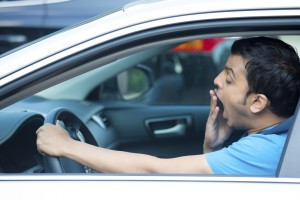Sunday morning, we lose an hour as we “spring forward” into Daylight Savings Time. It can take between 2 days and 2 weeks for your body to adjust to a time shift. With sleep patterns thrown off and your morning commute shifting back into darkness, your risk of a drowsy driving accident can double!
 Because fatigue and drowsiness can’t be tested or observed consistently like drunk driving, statistics on drowsy driving accidents vary. The National Highway Traffic Safety Administration (NHTSA) projects that drowsy driving is responsible for an average of 83,000 accidents, resulting in 37,000 injuries and 886 deaths each year.
Because fatigue and drowsiness can’t be tested or observed consistently like drunk driving, statistics on drowsy driving accidents vary. The National Highway Traffic Safety Administration (NHTSA) projects that drowsy driving is responsible for an average of 83,000 accidents, resulting in 37,000 injuries and 886 deaths each year.
A recent study from the University of Colorado Boulder indicates that in the six days following the shift to Daylight Savings Time, the risk of being involved in a fatal car accident increases 6.4%. The report projects that between 2002 and 2011, there were 302 deaths in that period.
Here are some steps you can take to “spring forward” safely:
Get More Zs!
Build in extra sleep time during this transition. Make sure to get 8 hours of sleep per night each of the next several nights, until your body adjusts to the time change.
The National Sleep Foundation recommends 7 – 9 hours of sleep for adult drivers. Sleeping less than that can double your risk of being involved in an accident.
Telework or go in later on Monday.
Take yourself out of the equation on that first day of Daylight Savings. If you can work from home that day, do it. If you can go into the office a little later, after the morning rush has tapered off, do that. Aside from staying safe, you get a break from the Monday routine. Win-win!
Get a breakfast boost.
Eating a good, balanced breakfast replenishes your body’s glucose levels and gives you the energy for your drive in, and beyond.
Jump-start with a workout.
Morning exercise releases endorphins and boosts your energy, helping to make you more alert and aware.
Prepare for glare.
If your commute takes you East in the morning, there’s a good chance you’ll be driving straight into the sun at some point in the next couple weeks. Make sure to clean your windshield, inside and out, to help minimize glare. And even if it’s dark when you leave the house, get your sunglasses out and ready, so that you don’t have to go digging for them when you suddenly need them.
Make a pit stop for coffee or a quick nap. Or both!
If you feel like you’re losing focus or your eyelids are getting heavy while you’re driving, get off the road as quickly and safely as possible. Stop somewhere to get coffee and/or take a 15-20 minute nap to recharge before getting back on the road.



